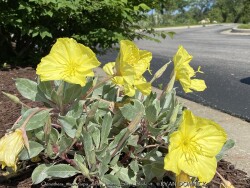

***Description for this perennial available with future update!***Silver Blade Missouri Primrose, is also known as Oenothera macrocarpa subsp. incana 'Silver Blade'


***Description for this perennial available with future update!*** Oenothera missouriensis / macrocarpa is also known as Yellow Missouri Primrose >>>>>>>>>>>>Missouri Primrose is a native wildflower with bright lemony yellow flowers occurring mostly in Kansas, Missouri, Oklahoma and Texas. native habitat includes limestone glades and bluffs, rocky prairies, and Great Plains. This wildflower also colonizes readily, will grow under the mover blades and can be found along state highways. Foliage is often a green to silver and also very attractive. Flowering is relatively short at 2 to 4 weeks but interesting green four-winged seed pods develop. These eventually break off and blow away spreading more seed. In the landscape, Missouri Primrose can be used in any dry soil situation including berms, hot south or west side of the house, or any other full sun area. These will grow in poor rocky, sandy or clayish soils and even rich organic soils with slightly increased root rot susceptibility. With our average 40 inches of rain per year in eastern Kansas, extra Irrigation is not recommended. Missouri Primrose can be planted in parking lot medians and other hell strips as a very durable groundcover. Combine with any other flower colors except yellow. There is quite a lot of diversity within the species so plants from different locales will have different foliage adapted to the site.
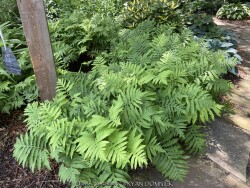

Sensitive Fern (Onoclea sensibilis) is a coarse-textured, medium to light green, deciduous perennial fern. Native to Asia and North America, it forms large colonies in forests growing best in moist shaded or partially shaded areas. It also colonizes wet meadows, thickets and bogs, as well as stream and riverbanks and roadside ditches. It tolerates extremely wet soils, can be aggressive in ideal locations but not so much in Kansas. It can spread rapidly in humusy, medium well-drained soil in part shade to full shade. Perfect in wet shade areas, north walls, areas without tree-root competition, or shaded rain gardens. It cannot handle prolonged Kansas droughts or dry-shade, but can tolerate dryer conditions in shade with good soils. Generally however, in non-irrigated or poor soil areas, this plant will decline and allow weeds to invade. Foliage finally dies back to the ground in early autumn with "fiddle-heads" emerging and unfurling in mid-spring. Generally this plant holds its own in Kansas climates but fails to spread very quickly. Look for a cold microclimate planting location such as East or North exposure. I have seen an established planting thriving on the north side of a customer's house for 20 plus years in zone 6a, Lawrence, KS.
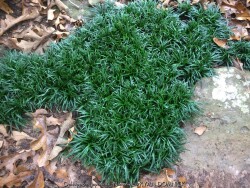

***Description for this perennial available with future update!***Dwarf Mondo Grass, is also known as Ophiopogon japonicus 'Nana'
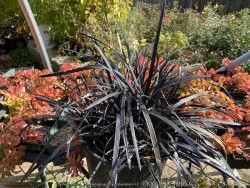

***Description for this perennial available with future update!***Black Mondo Grass, is also known as Ophiopogon planiscapus 'Arabicus'
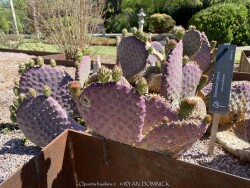

***Description for this plant available with future update!*** Opuntia basilaris is also known as Beaver Tail Cactus (Cold Hardy) >>>>>> With extremely well drained soils and proper siting, this cactus seems to take our excess rainfall in Eastern Kansas. These and other hardy barrel cacti are perfect for a dry mounded xeriscape gardens under south facing roof overhangs where it gets no winter moisture. We are also testing this outside in our Lawrence, KS (zone 6a) crevice garden among other cold-hardy cacti, succulents, and yucca! Watch for future updates-Jan-2025
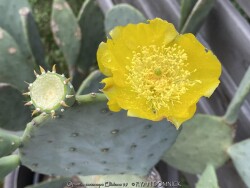

This prickly pear (Opuntia cacanapa 'Ellisiana') is truly spineless! Yes, completely spineless and free of glochids. The smooth green paddles and upright growth habit create a unique addition to the desert garden. The pads are sparsely spined, light green, and hardy to about 0 degrees F. This cactus has a place as one of the few upright cacti that can handle extreme cold. Ellisiana Spineless Prickly Pear is most often used as a patio plant in Kansas. Place in full sun with no extra watering except from rainfall. Repotting may or may not be needed depending on how large you want the plant to grow. Potted plants are hardy to at least 10 degrees F if kept dry so you can wait awhile to move these in for the winter. Then move into a cold garage, basement, or window over the winter with NO watering. Although un-tested by the author, this opuntia could survive in a microclimate under a south facing roof overhang kept completely dry in the winter and controlled water in the summer in zone 6a. Several plantings in Tulsa, Oklahoma at the Gathering Place endured temperatures as low as -11 degrees F along with prolonged cold (5 days of highs in the teens and lows in the single digits) in February, 2021. This interesting and "completely safe" cactus, when special ordered in quantity, can be used as an annual mass planting in the landscape. If grown as a patio or house plant, move to a bright interior window over the winter before extreme cold occurs with no watering and keep above freezing. If grown as a summer patio plant, move to a bright interior window over the winter before extreme cold occurs with no watering and keep above freezing. As a winter-only house plant, it will look presentable all winter long with just no waterings. As a permanent house plant, provide bright light and allow the soil to dry between waterings for many years of carefree enjoyment. Pads are easy to propagate.


This prickly pear (Opuntia cacanapa 'Ellisiana') is truly spineless! Yes, completely spineless and free of glochids. The smooth green paddles and upright growth habit create a unique addition to the desert garden. The pads are sparsely spined, light green, and hardy to about 0 degrees F. This cactus has a place as one of the few upright cacti that can handle extreme cold. Ellisiana Spineless Prickly Pear is most often used as a patio plant in Kansas. Place in full sun with no extra watering except from rainfall. Repotting may or may not be needed depending on how large you want the plant to grow. Potted plants are hardy to at least 10 degrees F if kept dry so you can wait awhile to move these in for the winter. Then move into a cold garage, basement, or window over the winter with NO watering. Although un-tested by the author, this opuntia could survive in a microclimate under a south facing roof overhang kept completely dry in the winter and controlled water in the summer in zone 6a. Several plantings in Tulsa, Oklahoma at the Gathering Place endured temperatures as low as -11 degrees F along with prolonged cold (5 days of highs in the teens and lows in the single digits) in February, 2021. This interesting and "completely safe" cactus, when special ordered in quantity, can be used as an annual mass planting in the landscape. If grown as a patio or house plant, move to a bright interior window over the winter before extreme cold occurs with no watering and keep above freezing. If grown as a summer patio plant, move to a bright interior window over the winter before extreme cold occurs with no watering and keep above freezing. As a winter-only house plant, it will look presentable all winter long with just no waterings. As a permanent house plant, provide bright light and allow the soil to dry between waterings for many years of carefree enjoyment. Pads are easy to propagate.


This prickly pear (Opuntia cacanapa 'Ellisiana') is truly spineless! Yes, completely spineless and free of glochids. The smooth green paddles and upright growth habit create a unique addition to the desert garden. The pads are sparsely spined, light green, and hardy to about 0 degrees F. This cactus has a place as one of the few upright cacti that can handle extreme cold. Ellisiana Spineless Prickly Pear is most often used as a patio plant in Kansas. Place in full sun with no extra watering except from rainfall. Repotting may or may not be needed depending on how large you want the plant to grow. Potted plants are hardy to at least 10 degrees F if kept dry so you can wait awhile to move these in for the winter. Then move into a cold garage, basement, or window over the winter with NO watering. Although un-tested by the author, this opuntia could survive in a microclimate under a south facing roof overhang kept completely dry in the winter and controlled water in the summer in zone 6a. Several plantings in Tulsa, Oklahoma at the Gathering Place endured temperatures as low as -11 degrees F along with prolonged cold (5 days of highs in the teens and lows in the single digits) in February, 2021. This interesting and "completely safe" cactus, when special ordered in quantity, can be used as an annual mass planting in the landscape. If grown as a patio or house plant, move to a bright interior window over the winter before extreme cold occurs with no watering and keep above freezing. If grown as a summer patio plant, move to a bright interior window over the winter before extreme cold occurs with no watering and keep above freezing. As a winter-only house plant, it will look presentable all winter long with just no waterings. As a permanent house plant, provide bright light and allow the soil to dry between waterings for many years of carefree enjoyment. Pads are easy to propagate. This offering is for un-rooted cuttings (pads) Pads need a few days to dry and callus to be ready to root.
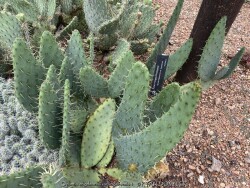

***Description for this plant available with future update!***The yellow flowers, maroon long lasting fruits, and upright growth habit of this cactus (Opuntia engelmannii var. linguiformis) create a unique addition to the desert garden. The pads are sparsely spined, light green, and hardy to about -5 degrees F. Native to arid soils in Texas and Oklahoma, this cactus has a place as one of the few upright cacti that can handle extreme cold. In fact, I have seen this species growing a in Lawrence, KS in desert gardens along a south wall of a house. With well drained soils and proper micro-climate, this cactus can handle our extreme cold and excess rainfall of Eastern Kansas with excellent drainage.
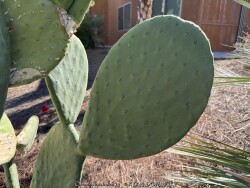

***Description for this plant available with future update!*** Opuntia ficus-indica is also known as Indian Fig Opuntia / Nopales / Tunas (Tropical).
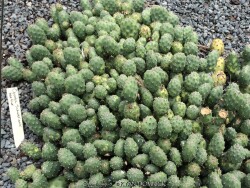

These tiny perennial succulent cacti (Opuntia fragilis 'Potato') produce globe-shaped, spherical stems make this selection unique. 'Potato' prickly pear is virtually spineless. It is native to mountainous areas in Western Colorado. The olive green "pads" take on a lovely winter blush of purple in cold weather. Grow this small native gem in a Kansas rock garden, in cracks between rocks, or on top of or in a retaining wall. You may also grow in flat areas like in between stepping stones provided you used a gravelly or sandy base for the stones. It will not tolerate rich moist soils as other plants or weeds will shade it out. Root rot can occur during lengthy hot humid summer rainy periods. If grown as a summer patio plant, move to a bright interior window over the winter before extreme cold occurs with no watering and keep above freezing. As a winter-only house plant, it will look presentable all winter long with just no waterings. Upon moving outside the following spring, plants with plenty of time to acclimate will thrive in full sun but be careful not to rush it or sunburning will occur. Generally if moving outside for the summer, allow 2-3 weeks of part shade or morning sun before placing in full sun. If grown in pots permanently outdoors, keep on the dry side in minerally sandy soil. You may leave out all winter allowing to freeze solid (Hardy to zone 4a); plants will go dormant and resume growth in the spring. As a permanent house plant, provide bright light and allow the soil to dry between waterings for many years of carefree enjoyment. Little potato-like pads are easy to propagate. Our original plant came from Plant Delights Nursery in North Carolina and also available on their mail-order website.
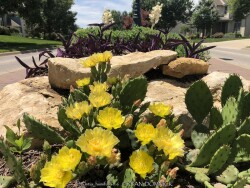

Eastern Prickly Pear Cacti (Opuntia humifusa) have attractive green pads, brilliant yellow flowers in June, and pinkish maroon edible fruits afterward that last into winter. They are native to eastern woods of Kansas, Missouri, Oklahoma, Texas, Arkansas and much of the Southeast United States. This cold hardy succulent occupies an unusual niche: growing in poor shallow sandstone based soils in open woods and on sunny rock cliffs that dry out too quickly for most other plants to colonize. Pads are sometimes carried off by animals and take root elsewhere. Grow this small native gem in rock gardens, dry shade areas, in parking lot medians, in cracks between rocks, or on top of or in a retaining wall. This species will grow in full sun or full shade! Although not picky about soils, just ensure that drainage is good. If grown in exterior pots and kept on the dry side, you may leave out all winter allowing to freeze solid; plants will go completely dormant and resume growth in the spring. Although these prickly pear do not have spines, they do have glochids. (painful bristles that come off and irritate the skin for a few days) Great low maintenance cold hardy and very versatile succulent.
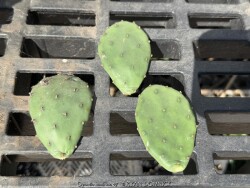

Eastern Prickly Pear Cacti (Opuntia humifusa) have attractive green pads, brilliant yellow flowers in June, and pinkish maroon edible fruits afterward that last into winter. They are native to eastern woods of Kansas, Missouri, Oklahoma, Texas, Arkansas and much of the Southeast United States. This cold hardy succulent occupies an unusual niche: growing in poor shallow sandstone based soils in open woods and on sunny rock cliffs that dry out too quickly for most other plants to colonize. Pads are sometimes carried off by animals and take root elsewhere. Grow this small native gem in rock gardens, dry shade areas, in parking lot medians, in cracks between rocks, or on top of or in a retaining wall. This species will grow in full sun or full shade! Although not picky about soils, just ensure that drainage is good. If grown in exterior pots and kept on the dry side, you may leave out all winter allowing to freeze solid; plants will go completely dormant and resume growth in the spring. Although these prickly pear do not have spines, they do have glochids. (painful bristles that come off and irritate the skin for a few days) Great low maintenance cold hardy and very versatile succulent.


Plains Prickly Pear Cacti (Opuntia macrorhiza) have attractive green pads, brilliant yellow flowers in June, and pinkish maroon edible fruits afterward that last into winter. They are native to much of the Great Plains from Texas to Minnesota. Pads are sometimes carried off by animals and take root elsewhere. Grow this small native gem in rock gardens, dry shade areas, in parking lot medians, in cracks between rocks, or on top of or in a retaining wall. Although not picky about soils, just ensure that drainage is good. If grown in exterior pots and kept on the dry side, you may leave out all winter allowing to freeze solid; plants will go completely dormant and resume growth in the spring. Although these prickly pear have spines and glochids. (painful bristles that come off and irritate the skin for a few days) so be careful around children and pets. Great low maintenance cold hardy and very versatile plant!
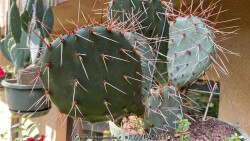

***Description for this plant available with future update!*** Opuntia phaeacantha is also known as Brownspine Prickly Pear / Tulip Prickly Pear Cactus (Cold Hardy)>>>>>> With extremely well drained soils and proper siting, this cactus seems to take our excess rainfall in Eastern Kansas. These and other hardy barrel cacti are perfect for a dry mounded xeriscape gardens under south facing roof overhangs where it gets no winter moisture. We are also testing this outside in our Lawrence, KS (zone 6a) crevice garden among other cold-hardy cacti, succulents, and yucca! Watch for future updates-Jan-2025
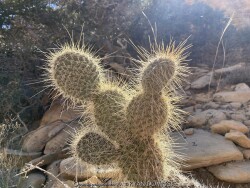

***Description for this plant available with future update!*** Opuntia polyacantha is also known as Colorado Plains Prickly Pear Cactus (Cold Hardy)>>>>>> With extremely well drained soils and proper siting, this cactus seems to take our excess rainfall in Eastern Kansas. These and other hardy barrel cacti are perfect for a dry mounded xeriscape gardens under south facing roof overhangs where it gets no winter moisture. We are also testing this outside in our Lawrence, KS (zone 6a) crevice garden among other cold-hardy cacti, succulents, and yucca! Watch for future updates-Jan-2025
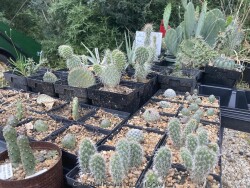

***Description for this plant available with future update!*** Opuntia polyacantha x cymochila 'Peter Pan' is also known as Dwarf Plains Prickly Pear Cactus (Cold Hardy)>>>>>> With extremely well drained soils and proper siting, this cactus seems to take our excess rainfall in Eastern Kansas. These and other hardy barrel cacti are perfect for a dry mounded xeriscape gardens under south facing roof overhangs where it gets no winter moisture. We are also testing this outside in our Lawrence, KS (zone 6a) crevice garden among other cold-hardy cacti, succulents, and yucca! Watch for future updates-Jan-2025
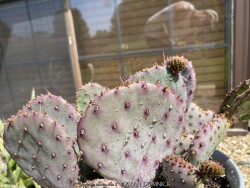

***Description for this plant available with future update!*** Opuntia santa-rita is also known as Santa Rita Purple Opuntia (Tropical)>>>>> Cacti are known for their spines, unusual shapes and beautiful flowers. Both succulents and cacti store water in their fleshy tissues. And can survive long periods without water. Cacti and succulents are usually grown as a deck/patio plant or house plant in Kansas. Grow in full sun with little to no extra watering except that which comes from rainfall. Generally, plants may be brought out in Late May through Early October in our zone 6a Lawrence, KS climate. To play is safe, potted plants are best moved in before autumn leaves begin to drop and before night temperatures get below 45 degrees F. It is very important to avoid the combination of wet and cold. Move to a bright interior window over the winter with little to no watering and keep above 50 degrees F. As a winter house plant, it will look presentable all winter long with little to no waterings. As a permanent house plant, provide bright light and allow the soil to dry completely between waterings and you will get many years of carefree enjoyment. Plants grown permanently indoors may eventually begin to elongate stretching for light and lose their spine color. It can be hard to reproduce the intense UV sunlight they need when growing indoors so moving outside for the summer is best. Generally if moving outside for the summer, allow 1-2 weeks of part shade or morning sun before placing in full sun. Plants with time to acclimate will thrive in full sun but be careful not to rush it or sunburning may occur. Repotting may or may not be needed depending on how large you want the plant to grow; plants can continue to grow taller and tolerate extremely root-bound pots but may need wind bracing. If repotting, make sure to use a sharp draining low organic cactus mix with plenty of sand and perlite but avoid peat moss. The “soil” most commercial cacti are potted in to too peaty and light weight. This soil becomes hydrophobic and shrinks after becoming bone dry and difficult to re wet again. Cacti never grow in peat-based soils in nature; this “Soil” is only good for shipping because of the light weight. Potted plants are very low maintenance but watch for scale and mealybugs that may hide beneath the cover of spines. The best pest removal approach is to periodically wash the cactus off. Achieve this with a water nozzle or hose breaker turned mostly off to increase the pressure from the blast of water. This high-pressured water kills the pests without damaging the thick cactus skin. Here are some little-known or rare factoids about cacti: 1. The "spines" are actually modified leaves filled with sap at first, then quickly drying out to form the spines! 2. Many cacti have bright colored flowers that mainly attract bees, while some tubular flowering types attract hummingbirds and bats. 3. Late on the evolutionary timeline, cacti fossils are rare to non-existent. Cacti are native almost exclusively to the Americas, while succulents can include a much larger plant palette be from any dry area in the world. 4. Some cactus plants have been known to survive more than 2 years without water. 5. Some cacti first evolved in a dry climate that later became wetter again. For example: several jungle species live as epiphytes in trees to achieve the fast drainage they need.
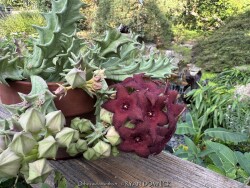

***Description for this plant available with future update!*** Orbea melanantha is also known as Black-Flowered Orbea (Tropical)>>>>> Cacti are known for their spines, unusual shapes and beautiful flowers. Both succulents and cacti store water in their fleshy tissues. And can survive long periods without water. Cacti and succulents are usually grown as a deck/patio plant or house plant in Kansas. Grow in full sun with little to no extra watering except that which comes from rainfall. Generally, plants may be brought out in Late May through Early October in our zone 6a Lawrence, KS climate. To play is safe, potted plants are best moved in before autumn leaves begin to drop and before night temperatures get below 45 degrees F. It is very important to avoid the combination of wet and cold. Move to a bright interior window over the winter with little to no watering and keep above 50 degrees F. As a winter house plant, it will look presentable all winter long with little to no waterings. As a permanent house plant, provide bright light and allow the soil to dry completely between waterings and you will get many years of carefree enjoyment. Plants grown permanently indoors may eventually begin to elongate stretching for light and lose their spine color. It can be hard to reproduce the intense UV sunlight they need when growing indoors so moving outside for the summer is best. Generally if moving outside for the summer, allow 1-2 weeks of part shade or morning sun before placing in full sun. Plants with time to acclimate will thrive in full sun but be careful not to rush it or sunburning may occur. Repotting may or may not be needed depending on how large you want the plant to grow; plants can continue to grow taller and tolerate extremely root-bound pots but may need wind bracing. If repotting, make sure to use a sharp draining low organic cactus mix with plenty of sand and perlite but avoid peat moss. The “soil” most commercial cacti are potted in to too peaty and light weight. This soil becomes hydrophobic and shrinks after becoming bone dry and difficult to re wet again. Cacti never grow in peat-based soils in nature; this “Soil” is only good for shipping because of the light weight. Potted plants are very low maintenance but watch for scale and mealybugs that may hide beneath the cover of spines. The best pest removal approach is to periodically wash the cactus off. Achieve this with a water nozzle or hose breaker turned mostly off to increase the pressure from the blast of water. This high-pressured water kills the pests without damaging the thick cactus skin. Here are some little-known or rare factoids about cacti: 1. The "spines" are actually modified leaves filled with sap at first, then quickly drying out to form the spines! 2. Many cacti have bright colored flowers that mainly attract bees, while some tubular flowering types attract hummingbirds and bats. 3. Late on the evolutionary timeline, cacti fossils are rare to non-existent. Cacti are native almost exclusively to the Americas, while succulents can include a much larger plant palette be from any dry area in the world. 4. Some cactus plants have been known to survive more than 2 years without water. 5. Some cacti first evolved in a dry climate that later became wetter again. For example: several jungle species live as epiphytes in trees to achieve the fast drainage they need.
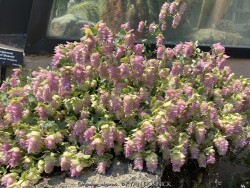

***Description for this perennial available with future update!*** Origanum 'Amethyst Falls' is also known as Amethyst Falls Ornamental Oregano.
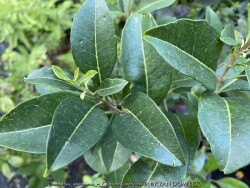

Devilwood (Osmanthus americanus / Cartrema americana) has very hard and dense wood, hence the name. It is a slow-growing evergreen shrub or small tree native to southeastern North America and Mexico. Bright green simple leaves emerge in spring turning deeper green in summer. Cream white flowers borne on separate trees and female trees produce abundant blue/black fruit. Growth habit is somewhat open so don't count on it to provide screening or density. Grows in sun or shade but in the northern part of its range, growth is too slow and sparse in the shade. Devilwood grows in most soils including moist ones and occasional flooding. This making it an ideal rain garden plant. Becoming more drought tolerant when established, our 40 inches of typical rainfall in Eastern Kansas is sufficient if planted in good soils. The cold hardiness is surprising: as a zone 5, this could be one of the most cold-tolerant broadleaf evergreens trees available! It survived -16 degrees F and a week of single digit highs in February, 2021 with no damage. It even maintains bright green foliage in winter opposed to a dingy brownish-green like some evergreens. Useful in the garden as a background evergreen shrub or small tree. Sold as Osmanthus americanus, Cartrema americana is technically it's new botanical name.
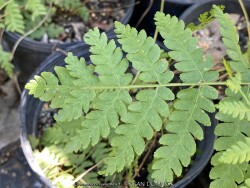

***Description for this plant available with future update!*** Osmunda cinnamomea / Osmundastrum cinnamomeum is also known as Cinnamon Fern.
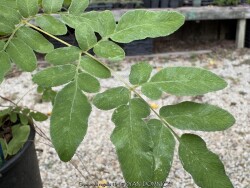

***Description for this plant available with future update!*** Osmunda regalis is also known as Royal Fern.
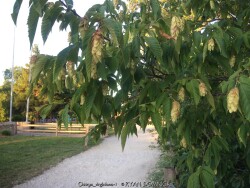

***Tree descriptions available with future update!*** Ostrya virginiana is also known as Eastern Hop Hornbeam


***Description for this perennial available with future update!*** Oxalis crassipes 'Rosea' is also known as Pink Wood Sorrel / Hardy Pink Shamrock.
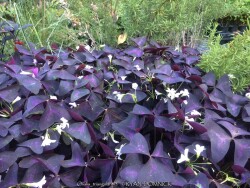

Oxalis triangularis is also commonly called Purple False Shamrock. It is a species of perennial plant native to several countries in southern South America. Grown mostly for its bright purple shamrock-like leaves and occasional pink flowers, the leaves also move in response to light levels, opening in high ambient light (in the day) and closing at low light levels (at night) In Kansas gardens it is normally grown in containers as an annual, patio plant or house plant. If grown in well drained soil planted in the ground in the right micro-climate (South-facing exposure), it may be a perennial. If low temperatures hit -10 degrees F, it may kill an un-mulched plant; protect any zone 6 perennial with thick layer of mulch. In our trial gardens in Lawrence, KS (zone 6a), three established specimens planted 3-4" deep and mulched 4-6" with leaf mulch survived -17 degrees F. During the arctic blast of February, 2021, lows down to -17 degrees F on Feb 16th, 2021 were recorded. The longevity of this cold blast was also impressive: 10 days on a row with highs of 10-15 degrees F or lower, 8 nights of lows in the single digits and negatives, and 36 straight hours of 0 degrees F and mostly lower. More testing would be good to evaluate true cold-tolerance.
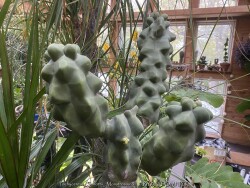

Pachycereus Schottii (Pachycereus schottii f. monstrosus) is native to the desert regions of mainland Mexico and the Baja California peninsula of Mexico. The monstrous form is restricted to a small area about halfway down the Baja peninsula. In the wild, established plants are hardy to about 25 degrees F for short periods of time. Totem pole cacti are usually grown as a patio or house plant in Kansas. Grow in full sun with occasional extra watering including that which comes from rainfall. Repotting may or may not be needed depending on how large you want the plant to grow; plants can continue to grow taller and tolerate extremely root-bound pots but may need wind bracing. If repotting, make sure to use a sharp draining medium organic cactus mix with plenty of sand and perlite. To play is safe, potted plants are best moved in before night temperatures get below 45 degrees F. It is important to avoid the combination of wet and cold. Before extreme cold occurs, move to a bright interior window over the winter with no watering and keep above freezing. As a winter house plant, it will look presentable all winter long with no waterings.(also to prevent lanky winter growth) As a permanent house plant, provide bright light and allow the soil to dry between waterings for many years of carefree enjoyment. Plants grown permanently indoors may begin to elongate stretching for light and lose their spine color. It can be hard to reproduce the intense UV sunlight they need so moving outside for the summer is best. Generally if moving outside for the summer, allow 1-2 weeks of part shade or morning sun before placing in full sun. Plants with time to acclimate will thrive in full hot sun but be careful not to rush it or sunburning can occur. Potted plants are very low maintenance. I have never seen any insect problems on this plant. Pachycereus schottii f. monstrosus is the most attractive monstrous form with pronounced knobby tubercles and smooth green skin; it is rare and will command a higher price than most other houseplants. Another naturally occuring monstrous form, Pachycereus schottii f. mieckleyanus, also has smooth green skin but thinner stems with less tubercles.
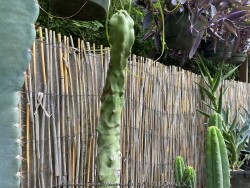

Pachycereus Schottii (Pachycereus schottii f. monstrosus) is native to the desert regions of mainland Mexico and the Baja California peninsula of Mexico. The monstrous form is restricted to a small area about halfway down the Baja peninsula. In the wild, established plants are hardy to about 25 degrees F for short periods of time. Totem pole cacti are usually grown as a patio or house plant in Kansas. Grow in full sun with occasional extra watering including that which comes from rainfall. Repotting may or may not be needed depending on how large you want the plant to grow; plants can continue to grow taller and tolerate extremely root-bound pots but may need wind bracing. If repotting, make sure to use a sharp draining medium organic cactus mix with plenty of sand and perlite. To play is safe, potted plants are best moved in before night temperatures get below 45 degrees F. It is important to avoid the combination of wet and cold. Before extreme cold occurs, move to a bright interior window over the winter with no watering and keep above freezing. As a winter house plant, it will look presentable all winter long with no waterings.(also to prevent lanky winter growth) As a permanent house plant, provide bright light and allow the soil to dry between waterings for many years of carefree enjoyment. Plants grown permanently indoors may begin to elongate stretching for light and lose their spine color. It can be hard to reproduce the intense UV sunlight they need so moving outside for the summer is best. Generally if moving outside for the summer, allow 1-2 weeks of part shade or morning sun before placing in full sun. Plants with time to acclimate will thrive in full hot sun but be careful not to rush it or sunburning can occur. Potted plants are very low maintenance. I have never seen any insect problems on this plant. There are 2 or more forms. Compared to Pachycereus schottii f. monstrosus, Pachycereus schottii f. mieckleyanus (Pachycereus schottii f. monstrosus 'Minor'), has smooth green skin but thinner stems with less tubercles. This form is faster growing.
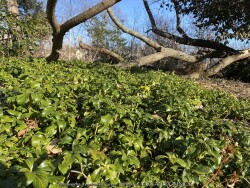

***Description for this perennial available with future update!***Green Sheen Japanese Pachysandra, is also known as Pachysandra terminalis 'Green Sheen'
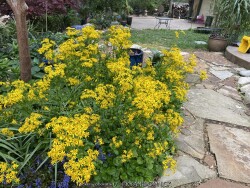

***Description for this perennial available with future update!***Native Roundleaf Groundsel / Packera, is also known as Packera obovata
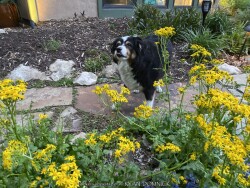

***Description for this perennial available with future update!***Native Roundleaf Groundsel / Packera, is also known as Packera obovata
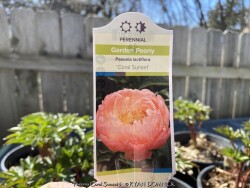

Peonies (Paeonia), along with roses are one of the most universally well-known flowers. The toughness and durability of this plant can be seen in cemeteries or around abandoned houses, surviving decades even 100 years or more without care. Peonies are native to China in cold continental climate areas but also do well in Kansas. Large flowers come in different shades of white, red, and pink. Peonies bloom usually around Memorial Day hence their popularity and cemeteries. Blooming lasts about 2 weeks but can be short-lived if a thunderstorm happens during the last week of blooming when petals are fully open. In zone 6 and south, the foliage is glossy green and attractive throughout the first half of summer. Usually, by late summer, foliage is tattered from drought stress and diseases. This has no ill effect on the health of the plant as it is already set its growth buds for next year. In northern areas (USDA zones 3-5), Peony foliage lasts all summer and turns a brilliant red and orange color in the fall. Due to its need for cold winters, peonies will not grow well further south than zone 8b. Gardeners in south Florida have had success getting peonies to bloom by dumping a bag of ice on the dormant plant every day for 5-6 weeks in winter: sounds like a lot of work huh! Due to its cold tolerance, peonies may be grown in above-ground pots or raised planters year-round. When planting outside, be careful to plant at the correct depth with pink buds slightly below the soil or plants will not bloom. Overall, peonies are a very reliable long-lived plant in Kansas surviving everything. But they do require some maintenance to look their best. Ultra cold-hardy plants from northern climates normally dislike our long hot humid summers; although we are on the Southern edge of this plant's adaptability, it still survives reasonably well here. Look for a cold microclimate planting location such as East or North exposure. Paeonia 'Coral Sunset' features double flowering multi-colored (Pink,Salmon,Peach,Gold) blooms.
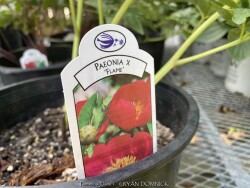

Peonies (Paeonia), along with roses are one of the most universally well-known flowers. The toughness and durability of this plant can be seen in cemeteries or around abandoned houses, surviving decades even 100 years or more without care. Peonies are native to China in cold continental climate areas but also do well in Kansas. Large flowers come in different shades of white, red, and pink. Peonies bloom usually around Memorial Day hence their popularity and cemeteries. Blooming lasts about 2 weeks but can be short-lived if a thunderstorm happens during the last week of blooming when petals are fully open. In zone 6 and south, the foliage is glossy green and attractive throughout the first half of summer. Usually, by late summer, foliage is tattered from drought stress and diseases. This has no ill effect on the health of the plant as it is already set its growth buds for next year. In northern areas (USDA zones 3-5), Peony foliage lasts all summer and turns a brilliant red and orange color in the fall. Due to its need for cold winters, peonies will not grow well further south than zone 8b. Gardeners in south Florida have had success getting peonies to bloom by dumping a bag of ice on the dormant plant every day for 5-6 weeks in winter: sounds like a lot of work huh! Due to its cold tolerance, peonies may be grown in above-ground pots or raised planters year-round. When planting outside, be careful to plant at the correct depth with pink buds slightly below the soil or plants will not bloom. Overall, peonies are a very reliable long-lived plant in Kansas surviving everything. But they do require some maintenance to look their best. Ultra cold-hardy plants from northern climates normally dislike our long hot humid summers; although we are on the Southern edge of this plant's adaptability, it still survives reasonably well here. Look for a cold microclimate planting location such as East or North exposure. Peony 'Flame' features single flowering red blooms displayed on the bold erect stems.
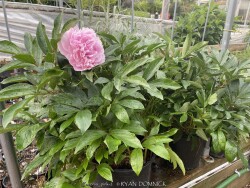

Peonies (Paeonia), along with roses are one of the most universally well-known flowers. The toughness and durability of this plant can be seen in cemeteries or around abandoned houses, surviving decades even 100 years or more without care. Peonies are native to China in cold continental climate areas but also do well in Kansas. Large flowers come in different shades of white, red, and pink. Peonies bloom usually around Memorial Day hence their popularity and cemeteries. Blooming lasts about 2 weeks but can be short-lived if a thunderstorm happens during the last week of blooming when petals are fully open. In zone 6 and south, the foliage is glossy green and attractive throughout the first half of summer. Usually, by late summer, foliage is tattered from drought stress and diseases. This has no ill effect on the health of the plant as it is already set its growth buds for next year. In northern areas (USDA zones 3-5), Peony foliage lasts all summer and turns a brilliant red and orange color in the fall. Due to its need for cold winters, peonies will not grow well further south than zone 8b. Gardeners in south Florida have had success getting peonies to bloom by dumping a bag of ice on the dormant plant every day for 5-6 weeks in winter: sounds like a lot of work huh! Due to its cold tolerance, peonies may be grown in above-ground pots or raised planters year-round. When planting outside, be careful to plant at the correct depth with pink buds slightly below the soil or plants will not bloom. Overall, peonies are a very reliable long-lived plant in Kansas surviving everything. But they do require some maintenance to look their best. Ultra cold-hardy plants from northern climates normally dislike our long hot humid summers; although we are on the Southern edge of this plant's adaptability, it still survives reasonably well here. Look for a cold microclimate planting location such as East or North exposure.
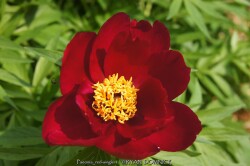

Peonies (Paeonia), along with roses are one of the most universally well-known flowers. The toughness and durability of this plant can be seen in cemeteries or around abandoned houses, surviving decades even 100 years or more without care. Peonies are native to China in cold continental climate areas but also do well in Kansas. Large flowers come in different shades of white, red, and pink. Peonies bloom usually around Memorial Day hence their popularity and cemeteries. Blooming lasts about 2 weeks but can be short-lived if a thunderstorm happens during the last week of blooming when petals are fully open. In zone 6 and south, the foliage is glossy green and attractive throughout the first half of summer. Usually, by late summer, foliage is tattered from drought stress and diseases. This has no ill effect on the health of the plant as it is already set its growth buds for next year. In northern areas (USDA zones 3-5), Peony foliage lasts all summer and turns a brilliant red and orange color in the fall. Due to its need for cold winters, peonies will not grow well further south than zone 8b. Gardeners in south Florida have had success getting peonies to bloom by dumping a bag of ice on the dormant plant every day for 5-6 weeks in winter: sounds like a lot of work huh! Due to its cold tolerance, peonies may be grown in above-ground pots or raised planters year-round. When planting outside, be careful to plant at the correct depth with pink buds slightly below the soil or plants will not bloom. Overall, peonies are a very reliable long-lived plant in Kansas surviving everything. But they do require some maintenance to look their best. Ultra cold-hardy plants from northern climates normally dislike our long hot humid summers; although we are on the Southern edge of this plant's adaptability, it still survives reasonably well here. Look for a cold microclimate planting location such as East or North exposure.
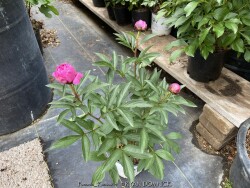

Peonies (Paeonia), along with roses are one of the most universally well-known flowers. The toughness and durability of this plant can be seen in cemeteries or around abandoned houses, surviving decades even 100 years or more without care. Peonies are native to China in cold continental climate areas but also do well in Kansas. Large flowers come in different shades of white, red, and pink. Peonies bloom usually around Memorial Day hence their popularity and cemeteries. Blooming lasts about 2 weeks but can be short-lived if a thunderstorm happens during the last week of blooming when petals are fully open. In zone 6 and south, the foliage is glossy green and attractive throughout the first half of summer. Usually, by late summer, foliage is tattered from drought stress and diseases. This has no ill effect on the health of the plant as it is already set its growth buds for next year. In northern areas (USDA zones 3-5), Peony foliage lasts all summer and turns a brilliant red and orange color in the fall. Due to its need for cold winters, peonies will not grow well further south than zone 8b. Gardeners in south Florida have had success getting peonies to bloom by dumping a bag of ice on the dormant plant every day for 5-6 weeks in winter: sounds like a lot of work huh! Due to its cold tolerance, peonies may be grown in above-ground pots or raised planters year-round. When planting outside, be careful to plant at the correct depth with pink buds slightly below the soil or plants will not bloom. Overall, peonies are a very reliable long-lived plant in Kansas surviving everything. But they do require some maintenance to look their best. Ultra cold-hardy plants from northern climates normally dislike our long hot humid summers; although we are on the Southern edge of this plant's adaptability, it still survives reasonably well here. Look for a cold microclimate planting location such as East or North exposure. Paeonia lactiflora 'Kansas' features double flowering magenta-carmine-red blooms are displayed on the bold, erect stems.
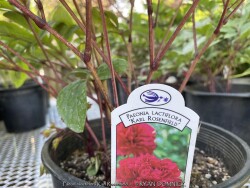

Peonies (Paeonia), along with roses are one of the most universally well-known flowers. The toughness and durability of this plant can be seen in cemeteries or around abandoned houses, surviving decades even 100 years or more without care. Peonies are native to China in cold continental climate areas but also do well in Kansas. Large flowers come in different shades of white, red, and pink. Peonies bloom usually around Memorial Day hence their popularity and cemeteries. Blooming lasts about 2 weeks but can be short-lived if a thunderstorm happens during the last week of blooming when petals are fully open. In zone 6 and south, the foliage is glossy green and attractive throughout the first half of summer. Usually, by late summer, foliage is tattered from drought stress and diseases. This has no ill effect on the health of the plant as it is already set its growth buds for next year. In northern areas (USDA zones 3-5), Peony foliage lasts all summer and turns a brilliant red and orange color in the fall. Due to its need for cold winters, peonies will not grow well further south than zone 8b. Gardeners in south Florida have had success getting peonies to bloom by dumping a bag of ice on the dormant plant every day for 5-6 weeks in winter: sounds like a lot of work huh! Due to its cold tolerance, peonies may be grown in above-ground pots or raised planters year-round. When planting outside, be careful to plant at the correct depth with pink buds slightly below the soil or plants will not bloom. Overall, peonies are a very reliable long-lived plant in Kansas surviving everything. But they do require some maintenance to look their best. Ultra cold-hardy plants from northern climates normally dislike our long hot humid summers; although we are on the Southern edge of this plant's adaptability, it still survives reasonably well here. Look for a cold microclimate planting location such as East or North exposure. Paeonia lactiflora 'Karl Rosenfield' features double flowering red to shades of magenta-carmine-reddish blooms that are displayed on the bold, erect stems.
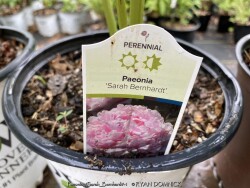

Peonies (Paeonia), along with roses are one of the most universally well-known flowers. The toughness and durability of this plant can be seen in cemeteries or around abandoned houses, surviving decades even 100 years or more without care. Peonies are native to China in cold continental climate areas but also do well in Kansas. Large flowers come in different shades of white, red, and pink. Peonies bloom usually around Memorial Day hence their popularity and cemeteries. Blooming lasts about 2 weeks but can be short-lived if a thunderstorm happens during the last week of blooming when petals are fully open. In zone 6 and south, the foliage is glossy green and attractive throughout the first half of summer. Usually, by late summer, foliage is tattered from drought stress and diseases. This has no ill effect on the health of the plant as it is already set its growth buds for next year. In northern areas (USDA zones 3-5), Peony foliage lasts all summer and turns a brilliant red and orange color in the fall. Due to its need for cold winters, peonies will not grow well further south than zone 8b. Gardeners in south Florida have had success getting peonies to bloom by dumping a bag of ice on the dormant plant every day for 5-6 weeks in winter: sounds like a lot of work huh! Due to its cold tolerance, peonies may be grown in above-ground pots or raised planters year-round. When planting outside, be careful to plant at the correct depth with pink buds slightly below the soil or plants will not bloom. Overall, peonies are a very reliable long-lived plant in Kansas surviving everything. But they do require some maintenance to look their best. Ultra cold-hardy plants from northern climates normally dislike our long hot humid summers; although we are on the Southern edge of this plant's adaptability, it still survives reasonably well here. Look for a cold microclimate planting location such as East or North exposure. Paeonia lactiflora 'Sarah Bernhardt' features enormous, fragrant, double flowers in rose pink with white edges.
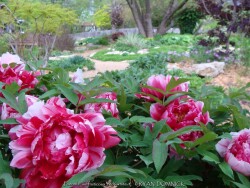

Tree Peonies (Paeonia suffruiticosa) are larger, woody relatives of the common herbaceous (perennial) peony. It does not die to the ground each winter, instead growing up to 3-5 feet after many years. Tree peonies have been in culture in China for millennia. Most "tree" peonies are really just shrubs and are grafted to the rootstock of herbaceous peonies. Peonies, along with roses are one of the most universally well-known flowers. The toughness and durability of this plant can be seen in cemeteries or around abandoned houses, surviving decades even 100 years or more without care. Both tree and herbaceous peonies are native to China in cold continental climate areas but also do well in Kansas. Large flowers come in different shades of white, red, and pink. Blooming only lasts about 3-7 days and can be short-lived if a thunderstorm happens during the second day of blooming when petals are fully open. The foliage is especially attractive in spring when unfurling into a flat, rich green and remains attractive throughout summer. Usually, by early fall, foliage is tattered from drought stress and diseases with no appreciable fall color. This has no ill effect on the health of the plant as it is already set its growth buds for next year. In northern areas (USDA zones 3-6), Peony foliage lasts all summer and turns brilliant red and orange colors in the fall. Due to its need for cold winters, peonies will not grow well further south than zone 8b. Due to its cold tolerance, peonies may be grown in above-ground pots or raised planters year-round. Ultra cold-hardy plants from northern climates normally dislike our long hot humid summers; although we are on the Southern edge of this plant's adaptability, it still survives reasonably well here. Several have been alive for over 15 years and bloom like clockwork each spring here in our Lawrence, KS display garden.
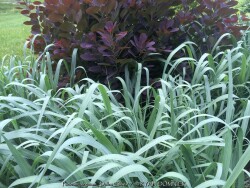

***Description for this grass available with future update!***Dallas Blues Switch Grass, is also known as Panicum virgatum 'Dallas Blues'
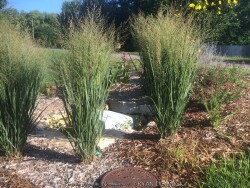

***Description for this grass available with future update!***Northwinds Switch Grass, is also known as Panicum virgatum 'Northwinds'
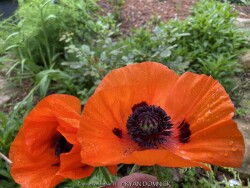

***Description for this perennial available with future update!*** Papaver orientale is also known as Orange Oriental Poppy >>>>>Ultra cold-hardy plants from northern climates normally dislike our long hot humid summers; although we are on the Southern edge of this plants adaptability, it still survives reasonably well here. Look for a cold microclimate planting location such as East or North exposure.>>>>>


***Description for this plant available with future update!*** Passiflora caerulea is also known as Blue Passionflower.
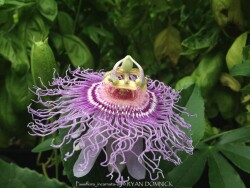

Hardy Purple Passionflower (Passiflora incarnata) is also called Maypop and is native to the eastern United States including Kansas. The plant features dark green tri-lobed leaves and tropical-looking purple and white flowers. The petals and sepals include a fringe of wavy or crimped hair-like segments with very pronounced pistils and stamens. Flowers bloom in summer and are fragrant. Fleshy, egg-shaped, edible fruits called maypops appear in July-August and mature to a yellowish color in fall. Ripened maypops can be eaten fresh off the vine or made into jelly. Maypop name refers to the loud popping sound made when fruits are stepped on. It's one of those "if you don't eat it, step on it plants"! Easily grown in a wide variety of soils including heavy clay. It is usually grown on structures that it can be easily removed from each year as it dies to the ground. We have it growing in our Lawrence, KS display garden mixed with a large patch of giant reed grass (Arundo donax) that all gets cut down each year. It weaves beautifully throughout the canes and allows for easy to harvest the fruits. Funny thing is, we did not plant it: it just showed up on its own. No other plants exist within several hundred feet! Beware that this is an extremely vigorous plant that crowds out most weeds and is itself weed-like, with a very spreading growth habit mainly from root suckers coming up freely. Best planted in wild areas where it can mix with other plants; mowing around it generally stops the yearly spread in lawn areas. Spot spraying errant shoots is also effective. "Once it's there, it's there forever" plant!
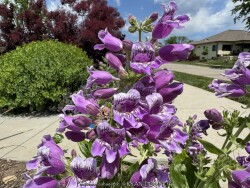

***Description for this perennial available with future update!*** Penstemon cobaea is also known as Showy Beardtongue / Cobaea Beardtongue.
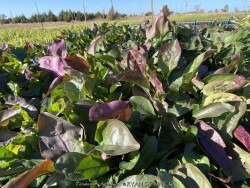

***Description for this perennial available with future update!***Foxglove Beardtongue / Native Penstemon, is also known as Penstemon digitalis.
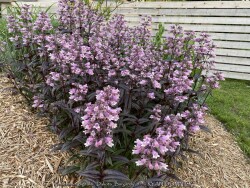

***Description for this perennial available with future update!***Dakota Burgundy Penstemon, is also known as Penstemon digitalis 'Dakota Burgundy'
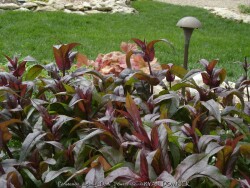

***Description for this perennial available with future update!***Dark Towers Penstemon, is also known as Penstemon digitalis 'Dark Towers'
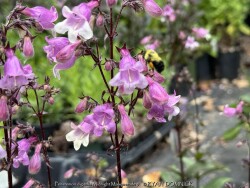

***Description for this perennial available with future update!***Dakota Burgundy Penstemon, is also known as Penstemon digitalis 'Dakota Burgundy'